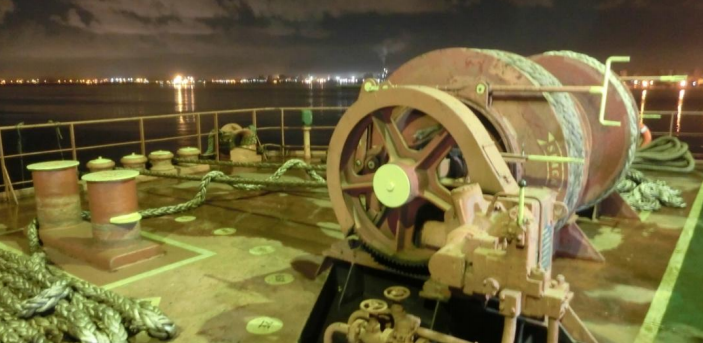Transport Malta’s MSIU issued an investigation report on a fatal occupational accident onboard the Maltese registered bulk carrier ‘Eleni M’, in November 2017. The fatal injury occurred as the crew member got trapped between the mooring rope on the winch drum and the deck on the poop deck. The safety investigation of the fatal accident revealed that in order to perform the task of stowing the mooring ropes on the winch drum, the crew members had to engage physically with the ropes while the winch was rotating
The incident
In the evening of 18 November 2017, ‘Eleni M’ departed Porto Marghera in Italy, bound for Alexandria in Egypt with a cargo consisting of iron. After departure, the crew members on deck began to tidy up in preparation for sea passage. On the aft deck, the mooring lines that had been used while the ship was in port were being secured on the two mooring winches.
During the final stage of the securing process, the last mooring line on the port side winch, the AB who arranged the mooring line on the winch drum assisted by one deck cadet, was caught in the winch and dragged into the limited clearance between the reeled-in mooring rope on the winch drum and the deck underneath.
This happened within only a few seconds, while the assisting cadet had approached the AB who was operating the winch to convey the message to stop reeling in. The AB got crushed between the deck and the mooring rope and was severely injured. He was later pronounced dead by a medical doctor on a Coast Guard vessel, which had come to assist and evacuate the casualty.
The safety investigation of the fatal accident revealed that in order to perform the task of stowing the mooring ropes on the winch drum, the crew members had to engage physically with the ropes while the winch was rotating, to stow it properly and make room for all of the rope. The close proximity to the rotating winch and physical interaction made it possible to get caught. Furthermore, communication among the crew members easily became ineffective due to the setup of the mooring arrangement and loud noises on the aft mooring deck.
Probable cause
The immediate cause of the fatal injury was the crew member being trapped between the mooring rope on the winch drum and the deck on the poop deck.
Conclusions
- With a situation that required careful stowage of the mooring ropes on the winches, in order to fit the excessive mass of ropes onto the winch drums, it was necessary to intervene physically, at a close proximity and with ropes on the winch while this was rotating. This granted the opportunity to get caught during the final stage of the stowage procedure, because of the limited clearance between the ropes and the deck.
- It was customary to stow more than four ropes because additional ones were used for mooring operations and because it was the most convenient way to stow these for sea passage.
- There was an insufficient number of winch drums available to hold every mooring rope individually.
- The clearance underneath the drum with the excessive mass of mooring rope stowed was severely limited, which made it possible to get caught between the remaining rope.
- The margins between success and failure was very narrow during the final stage of the mooring rope stowing procedure, with only a few seconds of inattention from the cadet, while he approached the winch operator to tell him to stop, being enough to allow the accident to materialise.
- The design of the work flow of securing the mooring lines and the physical setup of the mooring arrangement hampered good communication on the aft deck, because of the missing visual contact and the impossible verbal communication due to the noise levels.
- The task of stowing mooring lines to make ready for sea passage was a routine task that had been carried out successfully numerous times prior to the accident.
- Small variations in the everyday work performance may coincide in combinations and convert otherwise seemingly simple and routine operations, into serious accidents. In this case, intersecting circumstances related to timing, close human proximity to kinetic energy, design, and poor communication, were both difficult to predict and address in a Formal Risk Assessment.
The findings of the safety investigation, the conclusions reached and recommendations made shall in no case create a presumption of liability (criminal and/or civil) or blame.
Explore more herebelow:





























































